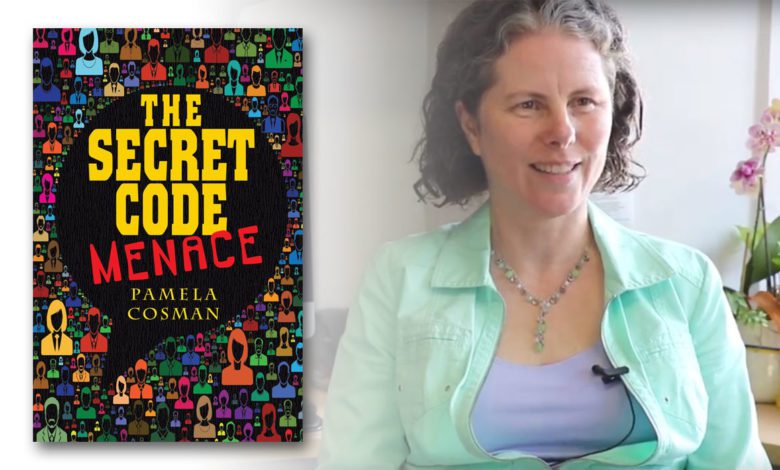
Pamela Cosman is the author or co-author of more than 250 published papers on image/video processing and wireless communications. Long involved with leading and participating in conferences, she was technical program co-chair for the 2018 IEEE International Congress on Multimedia and Expo (ICME).
So, it may come as a surprise that she also has written a well-received children’s book.
But Cosman, who is a professor of Electrical and Computer Engineering at the University of California San Diego (UCSD), is on a mission: to make STEM more appealing to youngsters.
“I’d love to see more American youngsters go into engineering,” she states. “If we can inspire more of them with the excitement and fun of math at an early age, they may decide to study to become engineers.”
Her book, The Secret Code Menace, teaches children aged 9-12 basic concepts about wireless communication, including error correction coding, binary numbers and interleaving. Moreover, since Cosman especially wants to attract more girls to engineering, one of the main characters is a girl. She is bright, creative and—in the final pages of the book—helps to save the day.
The plot revolves around siblings Sara and Jared Felton and their cousin, Daniel. Over the previous summer, the three created a simple information system using binary digits. Their messages, sent as paper notes or hand signals, are innocent enough—for example, “I told you so.” and “Angry at someone.” However, after a classmate sabotages a paper message that results in trouble (“Come over to my house.” becomes “Create a diversion.”), the three come up with solutions for detecting inaccurate transmissions.
Then, on a class field trip, the three protagonists find themselves in the middle of a bank robbery with a hostage situation. They quickly apply coded communications—with happy results for everyone–except the robbers.
Cosman makes excellent use of her experiences as both an educator, and the mother of four sons. She adds familiar touches to the narrative that include an irritating younger sister and a birthday party. Young readers will recognize and relate to these elements—while also remaining absorbed in the story.
An IEEE Fellow who specializes in data compression and image/video processing, Cosman initially got the idea for a children’s book years ago, when her oldest son was in second grade. (He is now 27, and working on his Ph.D. in—what else?—Computer Science.) Along with the parents of other students, teachers invited her to speak to his class about her work. Cosman talked about coding, making up a story to help explain basic concepts to the seven-year-olds. She also gave each of them a worksheet.
“At home that evening, my son reported that everyone spent all of recess and lunch time that day trying to solve the problems,” she relates. “That inspired me to write a book to excite and motivate children to explore technology. Error-correction, or channel coding, has so many applications used in the real world—for example, mobile phones, space communications and information storage.”
Cosman admits her first efforts to write a children’s book were challenging, because her manuscript read like a technical text, and she hadn’t yet learned how to write dialogue. She dropped the project for some years, while she worked full-time as a professor and brought up her children.
A few years ago, the need to present STEM topics to children in fun, relatable ways motivated her to revisit her early draft. After getting advice from children’s writers and editors, she revamped the manuscript, so it would appeal to children. Ransom Publishing, in the United Kingdom, published the book in 2016. It is also available from Amazon and the UC San Diego Bookstore.
Drawing from her experiences as a mother, she included an engineering-themed birthday party that she once gave for one of her sons in the book. At the party, the children compete to build structures—using uncooked spaghetti and marshmallows.
The book includes a chapter explaining how error correction coding is used in the real world, and describes coding applications and different kinds of codes. Also included here are the solutions to several coding puzzles the author has inserted in the story.
But Pamela Cosman’s non-technical interests don’t stop here. Given her own professional beginnings some 25 years ago—a young, female professor teaching in a male-dominated field—she is sensitive to the difficulties that both women faculty and students must deal with. As Faculty Equity Advisor for UCSD’s Jacobs School of Engineering, she conducts annual training in unconscious bias of all faculty search committees.
Since her appointment seven years ago, about 30 percent of all new hires have been women, significantly higher than the 11 percent who were on the engineering faculty in 2013. The number of underrepresented minority faculty hired has also increased substantially.
In addition, she serves as Co-Director of the UCSD Center for Research on Gender in Science, Technology, Engineering, Mathematics and Medicine (STEMM), where she researches gender effects on the pattern of questions and interruptions during employment interviews. Cosman has presented her findings, which show that women face significantly more questions and interruptions than men, at meetings of several key organizations, including the National Science Foundation (NSF), and the Electrical and Computer Engineering Department Heads Association (ECEDHA). Also important, for the last two hiring periods, she has incorporated the research findings into her training for faculty search committees.
To encourage student diversity, Cosman has helped to organize workshops on mentoring women in engineering, since her post-graduate years in the early 1990s at Stanford University. She is deeply involved with the NSF’s Redshirt in Engineering Consortium, which provides financial support and services to low-income freshman engineering students.
Cosman recently learned that she will be receiving national recognition for her achievements in diversity. The ECEDHA, composed of heads or chairs of departments offering accredited programs in electrical and/or computer engineering throughout the United States, will present her with its diversity award at the organization’s annual conference this spring.
Whether writing children’s books that encourage interest in STEM or contributing to national awareness about gender and diversity, Pamela Cosman is clearly making a difference in the worlds of education and engineering.
Helen Horwitz is an award-winning freelance writer who lives in Albuquerque, N.M. She was with IEEE from 1991 through 2011, the first nine as Staff Director, IEEE Corporate Communications.






